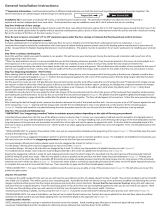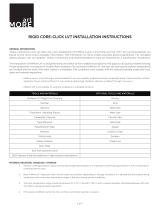
1
Residential Installation Guide —
Luxury Vinyl Tile Click
Mohawk Residential Installation Guide — LVT Click
Materials Required for Installation:
• Tape Measure
• Utility Knife
• Small Hand Roller (Seam Roller)
• Square Ruler
• Chalk Line
• Scrap piece of LVT/P material
tapping to tighten joints
Acceptable Underlayments
Mohawk’s LVT Click Products can be installed directly over most existing oor coverings, except for carpet, laminate, oating
oors systems and cushioned vinyl ooring.
• Wood Underlayment
Cangoovervirtuallyanysoundwoodunderlayments/suboors.Alwaysfastenunderlaymentinaccordancewiththe
manufacturer’srecommendations.For“specialneeds”gluedownapplications(steps,ramps,landings,etc.),Mohawk
recommendsunderlaymentsthatareunderlaymentgradeandwarrantedbythemanufacturer.Anyfailureofthe
underlaymentorooringasaresultoftheunderlaymentisNOTtheresponsibilityofMohawk.
• Concrete
Moisturelevelsofconcreteslabsbefore,duringandafterinstallationmustbe8lbs.orlessper100squarefeetper
24hoursusingananhydrouscalciumchloridetestaccordingtoASTMF1869andpHmustbebetween5.0and9.0;
or,ifusingASTMF2170IN-SituProbes,shouldbelessthan90%RH(relativehumidity).Insomeinstances,itmaybe
necessarytoadheretheLVTto“Specialneeds”areas(steps,ramps,landings,etc.)
• Radiant Heated Floors
Radiantheatedoorsmustbeapprovedbythemanufacturerfortheuseoftheirproductwithresilientvinylooring
applications.Thesuboortemperatureshouldnotexceed85°F(29°C)andthesystemshouldbeturnedoff24hoursprior
toandaftertheinstallation.Note:MohawkdoesnotrecommendtheuseofKalmunderlaymentwithradiantheatedoors.
Storage and Handling
Acclimate the ooring a minimum of 24 hours before installation in the area it is to be installed. Conditions between 65° F and
85° F (18° C and 29° C) are required before, during and after installation. Cartons should be evenly stacked no more than ve
high on a at surface and away from any heating/cooling ducts or direct sunlight.
Suboor and Wall/Door Preparation
Note:DonotinstallcabinetsontopofoatingLVT. The surface beneath the oor must be sufciently prepared in advance to
guarantee a successful installation of the ooring.
• Fill any low spots in the suboor greater than 3/16 inch in 10 foot span with a Portland cement leveling compound.
• Ceramic tile and embossed ooring will require skim coating with a Portland based patch to avoid bottom up
pattern telegraphing.
• Remove any existing oor molding. Removal of wall baseboards is optional as a quarter round can be installed to
avoid baseboard removal.
• Undercut doorjamb so the ¼ inch expansion space is maintained, allowing the LVT to slip under doorjamb/case molding.
• Sweep the suboor clean. The oor must also be free of all contaminants.
PLEASE NOTEwarrantyexclusionswithrespecttorollingloads.Ifyouhavefrequentorheavyrollingconditions,click
productscanbeglueddowntohelpreducetheriskofjointseparationfromrollingloadtrafc;howeverourwarrantystill
excludesanyproblemsassociatedwithrollingloads.

2
Residential Installation Guide — LVT Click
Start of Installation
It is the installer’s responsibility to inspect the ooring prior to installation to ensure that there are no visual defects. Donot
installooringwithvisibledefects.Ifvisibledefectsarepresent,contactyourretailerimmediately.
• Floor must be clean, smooth, at and dry before installation.
• Check the tongue and groove to assure it is free of debris or damage.
• To achieve maximum appearance, mix planks from two to three cartons from the same production.
The advantage of Mohawk LVT Click product is that it allows you to choose your own starting position, direction and can
work one plank/tile at a time.
Walls are not always straight. Snap a chalk line for your rst row to follow.
Maintain a ¼" (½ cm) expansion space around all walls. Quarter round or baseboard molding will cover this expansion
space. IMPORTANT: Maintain the 1/4 inch space around cabinets, pipes, toilet anges and any obstacle in the oor.
• For plank installation, we recommend staggering the end joints a minimum of 6 inches.
• For tile installation, we recommend staggering the end joints a minimum of 3 inches.
NOTE: Do not install four corners together, as this will not provide a stable installation.
Clicking Planks/Tiles Together
To click the end joint of the plank/tile together, click the short side of the plank/tile vertically into the previous one by
pressing it by hand and rolling it with a hand roller or seam roller to ensure a fully compressed tight t.
To click the length joint of the plank/tile together, place long joint together, lifting slightly to engage lock. Rotate
downward, clicking together for a tight t. Use a small hand roller or seam roller to press/lock the compression t end joint.
To tap along the entire length of plank or tile to properly seal the joint, use a small scrap piece of plank/tile with the lock
on the edge. Lock groove-to-tongue or tongue-to-groove for this application. Lock the scrap piece to the area requiring
tapping, and lightly tap the edge of the material. This will bring the tile edges tight together. Do not use a tapping block.
Cut the plank/tile by scoring through the top wear layer with a utility knife then snap the plank/tile across the score.
Install adjoining rows as you did the rst; one piece at a time. Holding the plank/tile at a slight angle, place it against the
prole in the rst row. Rotate the plank/tile down to secure the length joint ensuring there are no gaps along the joint.
The adjoining planks/tiles are aligned by sliding the long joint into position, shifting it to properly match the end joint
against the previous plank/tile. Repeat until you reach the nal row of material.
To install the nal row of planks/tiles, you will usually need to cut them. We recommend the following: lay a panel on top of
the last row installed. Lay another plank/tile against the edge of the wall. Mark the plank/tile underneath. Cut the plank/tile
through the wear layer and snap along the score. Install the last row leaving ample expansion space.
Additional Notes
Molding and Transitions Installation
• All molding and transition strips need to provide a ¼ inch expansion space to allow expansion and contraction of
the suboor. Ensure moldings and transition strips will not pinch the ooring.
• Never allow nails or screws to enter into the LVT ooring or the expansion zone around the ooring perimeter, as
it will prevent proper expansion of the structure and ooring.

3
Residential Installation Guide — LVT Click
Treads, Risers and Ramps
Glue down method is required on all treads, risers and wheelchair ramps. Install the riser after installing the tread. Install stair
nose moldings afterwards to protect the edge of the LVT.
Plank Replacement
Should one of your planks/tiles become damaged and need to be replaced, follow these simple instructions:
1. Score top of damaged plank/tile with a utility knife. Make two triangle cuts near the end joint and then connect the
points with one long cut in the middle of the plank/tile. (See diagram below)
SCORE TILE AS SHOWN
2. Use an awl or screwdriver to tap down through plank/tile on scored triangle cut points.
3. Lift and remove damaged tile.
4. With the pattern side facing up on the new replacement plank/tile, trim off the short lip on the tongue side and the
groove on the compression joint side, making it ush with the edge of the plank/tile. Be careful not to damage the
nish surface of the tile.
5. Cut several pieces of acrylic double face tape made for vinyl oors and slide under the edges of the existing oor on
the two edges where the replacement plank/tile will have its lips cut off. Tape should face sticky side up; leave the
paper on the side facing down on the oor.
6. Run a small bead of seam sealer on the groove edge of the planks/tiles on the existing oor where the replacement
plank/tile will rest that has lips cut off.
• NOTE: The long tongue of the replacement plank/tile and the uncut compression t end joint will not
need tape or seam adhesive as you will be using the plank’s/tile’s locking mechanism.
7. Install replacement plank/tile by sliding the long groove of the replacement plank/tile under the tongue of the oor
plank/tile until the nish edge of the replacement plank/tile is tight against the nish edge of the oor plank/tile, and
the compression end joint is lined up. Rotate down, locking the long tongue joint and roll the compression end joint
to lock into place with a small or hand roller.
8. Wipe an excess sealer that comes to the surface of the tiles with a damp cloth and follow with a dry cloth to assure all
sealer is removed from tile surface.
9. Keep foot trafc off the replaced plank/tile for 24 hours.
* Mohawkwillnotberesponsibleforproblemsthatmayariseforseamsealers.Pleasecontacttheseamsealer’smanufacturerwithissues.
Groove on
compression
jointside
Shortliponthetongueside
Patternsideup
MHLVTIG062018
-
 1
1
-
 2
2
-
 3
3
Ask a question and I''ll find the answer in the document
Finding information in a document is now easier with AI
Related papers
-
Mohawk S935LW.333 Installation guide
-
Mohawk S935LW.343 Installation guide
-
Mohawk LWCSS467 Installation guide
-
Mohawk HCE54-72 User guide
-
Mohawk LSO23-62 Installation guide
-
Mohawk LWCSS401 User manual
-
Mohawk HCL12-32 Installation guide
-
Mohawk HCL10-02 Installation guide
-
Mohawk 360663 User manual
-
Mohawk 360663 User manual
Other documents
-
TrafficMASTER A63134 Installation guide
-
SMARTCORE LX50100001 Installation guide
-
Home Decorators Collection 360489 Installation guide
-
TrafficMASTER A63133 Installation guide
-
Pergo PERFLRMTE Installation guide
-
 Innovations 933178 Installation guide
Innovations 933178 Installation guide
-
M-D Building Products 75572 Installation guide
-
Roberts 50-040 Installation guide
-
 CalFlor SA92253 Specification
CalFlor SA92253 Specification
-
 Artmore Tile EXT3RD105858 Installation guide
Artmore Tile EXT3RD105858 Installation guide





